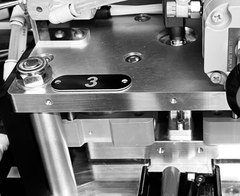San Diego, California – April 20, 2021
Wildcat Discovery Technologies, a technology company that uses proprietary high throughput methods to rapidly develop new battery materials, announced today that its engineering team has developed a new Linear Displacement Measurement (LDM) Device that measures small thickness changes in pouch cells during cycling.
Developed in partnership with BMW Group, Wildcat’s LDM capability allows new cell performance feedback as part of projects with its collaboration partners. Measurements of electrode thickness changes can help diagnose failure mechanisms, which can then be used to create improved electrode formulations that mitigate expansion and contraction. Examples of relevant project topics include silicon anode development, lithium metal evaluation, and swelling vs. cycle life correlative studies. The device design is flexible and accommodates a wide range of pouch cell sizes and thicknesses made by Wildcat or its customers. The device is sensitive enough to get useful data with both single and multi-layer cells.
Dr. Dee Strand, CSO of Wildcat Discoveries, added “With the Wildcat LDM device, the cell pressure is selected based on chemistry and then held constant during cycling. The device accuracy is +/- 1 micron with 0.1 micronresolution which is sensitive enough to detect changes for all cell chemistries – even in single layer pouch cells. We are thrilled to now incorporate this important measurement in many of our customer projects.”
Wildcat’s LDM instrument has no observable hysteresis or drift during the measurement, and can be operated over a wide range of temperatures. Wildcat has already successfully used its new invention to accurately measure dimensional changes during first cycle charge/discharge and cycling at multiple c-rates for cells containing LCO//graphite, NMC//graphite, NMC//silicon, and LCO//lithium.
Wildcat is now building many additional units to increase capacity for this already-popular measurement capability. For more information on how to incorporate use of Wildcat’s new LDM technology in your next project, please contact Jon Jacobs at [email protected].
About Wildcat Discovery Technologies
Wildcat Discovery Technologies accelerates the discovery of new materials for energy applications, with a focus on the development of advanced materials for rechargeable and primary batteries. Wildcat’s experienced team of scientists uses proprietary high-throughput tools to rapidly develop and optimize breakthrough materials, with corporate partners throughout the global battery and materials supply chains. Wildcat has also been named one of the “50 Most Innovative Companies” by Technology Review magazine. Please visit www.wildcatdiscovery.com for more details about Wildcat and its battery work.
For more information about Wildcat’s joint development agreement opportunities, please contact:
Jon Jacobs
Wildcat Discovery Technologies
VP, Business Development
(858) 550-1980 x114
[email protected]
